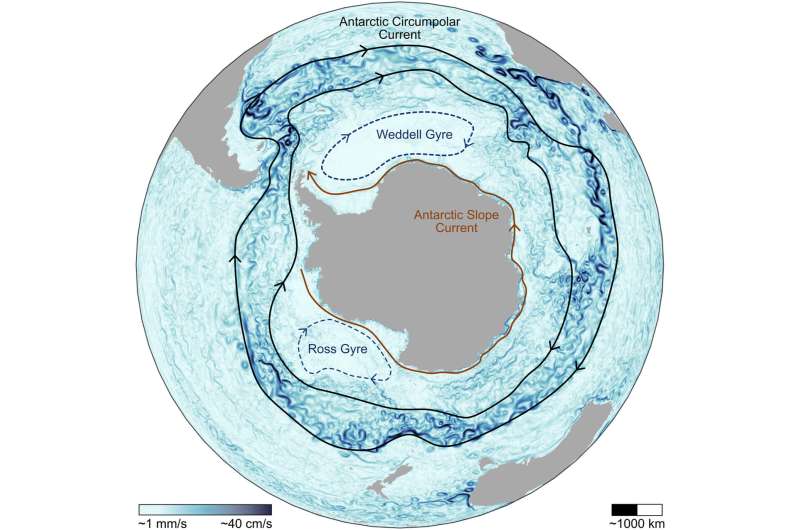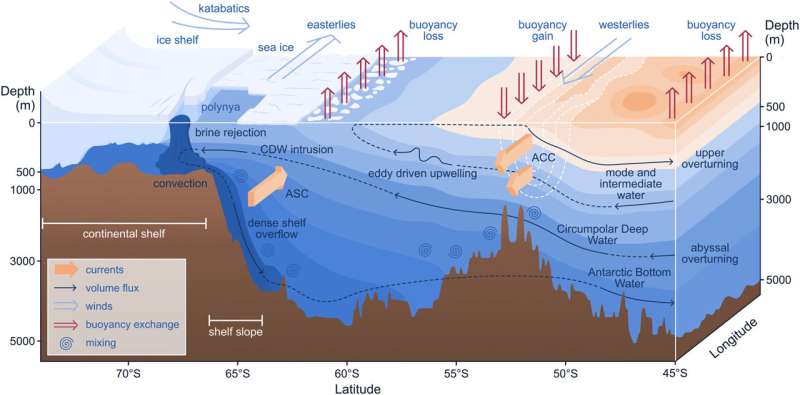This article has been reviewed according to Science X's editorial process and policies. Editors have highlighted the following attributes while ensuring the content's credibility:
fact-checked
proofread
How climate scientists are unraveling the mysteries of the Southern Ocean

The Southern Ocean is important for the Earth's climate system, particularly in absorbing excess heat and carbon from the atmosphere. However, its intricate dynamics remain poorly understood, hindering accurate climate impact predictions.
Recent technological advancements and improved data collection are transforming scientists' knowledge about the Southern Ocean dynamic system. With global oceans undergoing unprecedented changes due to rising temperatures, understanding these transformations is crucial for predicting potential climate impacts.
A new paper, "Closing the loops on Southern Ocean dynamics: From the circumpolar current to ice shelves and from bottom mixing to surface waves," published in Reviews of Geophysics, reveals how a community of multidisciplinary climate scientists has integrated previously isolated research areas.
Co-authored by more than 30 Australian and New Zealand climate science experts, the paper explores the Southern Ocean's climate dynamics, emphasizing the crucial role of sea ice and ice shelves in large-scale ocean circulation and global mixing.
The review covers the Southern Ocean from the seafloor to the surface and from its northernmost reaches to Antarctica's icy boundaries. It also outlines trends and future climate projections and identifies critical research priorities, demonstrating the interconnectedness of Southern Ocean processes and their implications for our global climate.
The ARC Center of Excellence for Climate Extremes spoke with several of the paper's co-authors about their involvement in the review, the challenges they aim to address, and why it's important to inspire a new generation of multidisciplinary scientists to link previously unrelated research to help address climate change.
A collaborative review of Southern Ocean climate links
Luke Bennetts, an Australian Research Council Future Fellow and Associate Professor in the School of Computer and Mathematical Sciences at the University of Adelaide, is an applied mathematician who focuses on Antarctic marginal ice zone dynamics and iceberg calving. He thrives on multidisciplinary collaborations that validate theoretical models with empirical data.
As one of the paper's lead authors, Bennetts emphasizes the interconnected nature of Southern Ocean processes and the benefits of broadening the research scope through collaborative efforts. "The article snowballed from conversations and enthusiasm within the broader community," explains A/Prof. Bennetts.
"Being part of the Southern Ocean/Antarctic community in Australia has made me understand the interconnected nature of the dynamic Southern Ocean processes and that my research benefits from developing knowledge about processes beyond my own immediate research focus," he says.
He points to the response of ice shelves to Antarctic sea ice losses as a critical area needing further study and advocates for policies supporting coordinated, holistic research. He also stresses the necessity of ongoing communication and collaboration to achieve this, noting, "The priority is for research communities to create regular opportunities to communicate and collaborate."
"We are all driving towards the common goal of understanding the changes occurring in the Southern Ocean and projecting future scenarios. The goal revolves around coupled numerical models, and we will only make the major advances needed if the experts in each community collaborate in developing these models and interpreting their outputs," he says.
Shane Keating, an A/Prof. of mathematics and oceanography at UNSW Sydney, specializes in ocean dynamics, satellite remote sensing, and data assimilation and forecasting. He stresses the importance of new data streams and tools that have revolutionized our understanding of the Southern Ocean.
"The Southern Ocean is a key player in Earth's climate, linking the world's oceans. However, our understanding of Southern Ocean dynamics has been severely limited by the challenges of making scientific observations in this remote and inhospitable region of the globe.
"In recent years, our view of the Southern Ocean has been revolutionized by the availability of new data streams from satellites, ocean drifters, and autonomous vehicles (like ocean gliders), as well as the numerical models and data science analysis tools we need to make sense of these observations."
A/Prof. Keating also identifies the need for a multidisciplinary effort to model the Southern Ocean's response to anthropogenic forcing as a key priority. Specifically, he says this review paper can act as a catalyst for cross-disciplinary research, leveraging new observational platforms and data-driven tools to inspire further research.
"Large-scale scientific endeavors are built on collaboration. Progress is often driven by many smart people working together to tackle a problem from many different angles. Given the challenges of conducting research in the Southern Ocean, collaboration is essential," he says.
"Governments need to make long-term commitments to scientific study of Antarctica and the Southern Ocean. That is not going to be easy—Southern Ocean research is costly and logistically challenging. But it is crucial if we are going to be able to accurately predict and adapt to a warmer world."

Addressing gaps in Southern Ocean research requires a multidisciplinary approach
Amelie Meyer, a Senior Research Fellow at the Institute of Marine and Antarctic Studies (IMAS), University of Tasmania, and a Chief Investigator with the ARC Center of Excellence for Climate Extremes, focuses on the influence of sea ice and the ocean on global climate. Her collaboration was sparked by an invitation and a deep sense of curiosity. Meyer hopes the review will serve as a comprehensive resource for both new and seasoned researchers.
"I hope this review will be a one-stop place for training scientists who are learning about Southern Ocean dynamics," says Dr. Meyer. "It will also be useful for senior researchers who might know a lot about a topic like wind and storms in the Southern Ocean but need to brush up on other topics like sea ice and ice shelves."
Dr. Meyer stresses the urgency of combining knowledge across disciplines to understand and address the rapid changes in the Southern Ocean due to climate change.
"With climate change, our environment, including the Southern Ocean, is changing faster than ever before. If we are to understand how the Southern Ocean is changing, what part is attributable to climate change, what the impacts are on our society and what we can do about it, we definitely have to combine research knowledge across disciplines and specialties.
"At the moment, sea ice in the Southern Ocean has really become an enigma. Sea ice used to be quite stable in the Southern Ocean, even with the warming of the planet. But in recent years, sea ice has been quite erratic, with a lot less than usual and this has happened quite suddenly. The research community is still working on understanding these changes and also their impacts.
"Sea ice plays a big role in regulating the climate of our planet and is also a home for key species and ecosystems. So understanding these changes is pretty urgent," she concludes.
Callum Shakespeare, a Senior Lecturer at the Research School of Earth Sciences at the Australian National University and a Chief Investigator at the ARC Center of Excellence for Climate Extremes, applies physics and math to understand ocean, atmosphere, and climate processes. He was drawn to the opportunity to share knowledge across different fields about the critical Southern Ocean.
"One priority is to better understand and model the ice-ocean interactions responsible for the melting of the Antarctic Ice Sheet," he says.
"The melt rate of the ice sheet is currently the biggest uncertainty in projections of sea level rise in the coming century, and it is crucial to narrow this uncertainty to facilitate better coastal infrastructure planning and target mitigation activities."
He highlights the Southern Ocean's role as a climate buffer as an area needing better understanding and observation, explaining, "The Southern Ocean is so vast and complex that no single scientist can be the expert in everything relevant to the system.
"The biggest and most important questions in the field, which have major implications for our environment and economy, involve many aspects of the system and require broader knowledge than that held by one scientist. Therefore, collaborative efforts are essential to addressing these big questions."
Dr. Shakespeare also underscores the importance of increased investment in ocean science.
"Given the rapid speed of changes being observed in the Southern Ocean (such as the lowest ever sea ice cover in recent years), it is more important than ever that we invest in understanding and better observing this vast ocean area to Australia's south, and the implications of its changing state for our climate."
Finally, Nicole Jones, a Professor at the University of Western Australia, explains how she uses field observations to study ocean processes and improve predictions. She identifies the need for more observations of small-scale processes in the Southern Ocean as a critical priority.
"In my view, the biggest priority identified was the need for more observations of the Southern Ocean, particularly of processes at the small scales.
"It is a challenging environment to work in but also reasonably unique; therefore, careful observations are needed to make breakthroughs in our understanding."
Prof. Jones says the review has set valuable directions for future research efforts and that new research connections could lead to fruitful collaborations.
"The new connections made among the team of writers could lead to very fruitful new collaboration. In addition to synthesizing the current state of knowledge, the review identified gaps in knowledge. I think together we have provided valuable direction for future research efforts," she says.
Community building is crucial to advancing climate science
The researchers stress the need for more observations, particularly of small-scale processes, to improve data collection and modeling and call for policies that support coordinated, holistic research through enhanced national and international collaboration.
"Australia has a duty to lead the world in Southern Ocean research," explains A/Prof. Bennetts.
"I would like to see policies that ensure coordinated, holistic research, which recognizes the combined importance of theory/process modeling, physical modeling, observations and numerical modeling towards the goal of understanding the role of the Southern Ocean in the global climate."
More information: Luke G. Bennetts et al, Closing the Loops on Southern Ocean Dynamics: From the Circumpolar Current to Ice Shelves and From Bottom Mixing to Surface Waves, Reviews of Geophysics (2024). DOI: 10.1029/2022RG000781
Provided by ARC Centre of Excellence for Climate Extremes (CLEx)





















